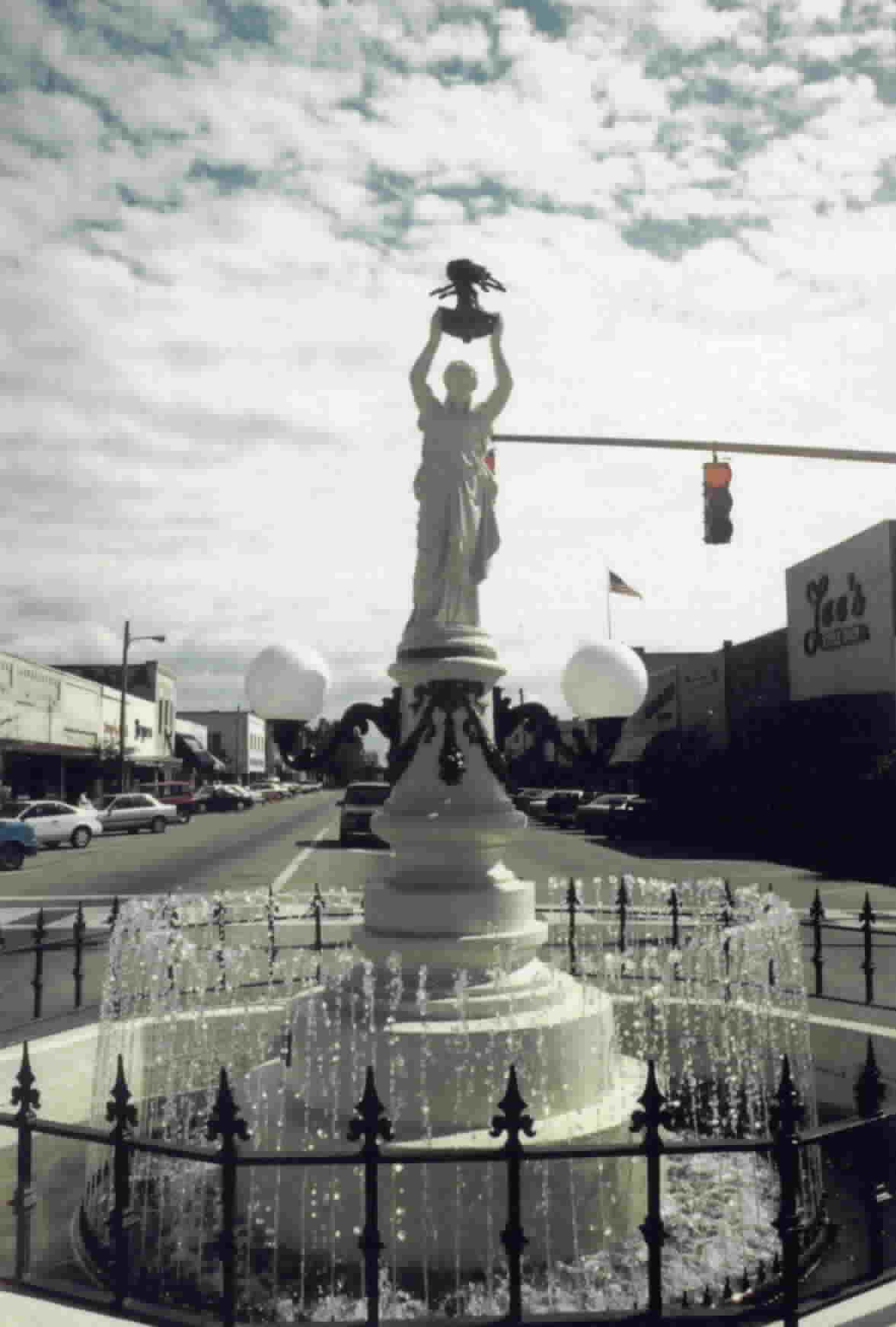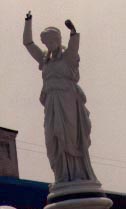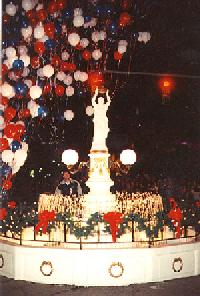

One of the most unusual attractions in Alabama is the Boll Weevil Monument, which its hometown of Enterprise often touts as the world's only monument honoring a pest. Some dispute this distinction, saying perhaps big bug logos adorning pest control companies or other such "statues" are also monuments honoring a bug, but that's a bit of a stretch. In any case, Enterprise probably has the first bug monument, and arguably has the only one that actually pays tribute to a pest.
The monument was dedicated on Dec. 11, 1919, at the intersection of College and Main streets in the heart of what was then the city's downtown business district. The monument consists of a statue of a lady wearing a flowing white gown, arms stretched above her head to to display a big black boll weevil. The pair stand 13-and-a-half feet above street level and are surrounded by a lighted fountain.
Both the lady and her bug have gone through a few trials and tribulations over the years, which have included theft and vandalism, but they were always restored and today remain as a unique symbol of Enterprise, not to mention a source of pride for many. The city is even nicknamed "The Weevil City."
The history of the monument dates back to the early 1900s when a bit of bad luck
led to some resourceful thinking that brought on a new era of prosperity.
The trouble actually started winding its inevitable way toward Enterprise when the
the boll weevil crossed over from Mexico and entered Texas, heading for the South
and leaving devastated fields in its wake. This was bad news for farmers in Coffee County,
where Enterprise was and is the largest city, because they all banked on cotton crops -
something the little bugs loved.
Disaster struck when the boll weevil finally reached Coffee County in 1915.
It destroyed many cotton crops, leaving farmers in a financial bind and the area in a slump.
However, one Enterprise businessman realized the boll weevil was on a course to severely
damage local prosperity, so he took matters into his own hands. His name was H.M. Sessions,
and he determined that peanuts would make a good crop for the area. In 1916 he convinced
a deeply-indebted farmer named C.W. Baston to take a chance on peanuts for one year.
Baston was a cotton farmer who had been hit hard by the boll weevil, and Sessions' offer to
supply the peanuts for planting, a picker to harvest them with, and $1 a bushel was too good
to refuse.
Baston's crop was a success, leaving him able to pay off debts and have money in the bank.
The 8,000 bushels of peanuts he produced were used as seed by other farmers who by then were
clamoring to get into the peanut-growing business.
Before this, farmers pretty much bet their farm on King Cotton - it was their only real
cash crop and they didn't have anything else to fall back on. Baston's success with peanuts,
however, convinced other farmers to diversify their crops, too. Cotton was still important,
but it was no longer the only game in town. Thanks to the hard times brought on by the boll
weevil, farmers were forced to make some changes that brought a new era of prosperity
to Coffee County.
It wasn't long before another local businessman, Bon Fleming, came up with the
idea to honor the bugs for forcing farmers to diversify crops. That seems strange to some,
but time proved it wasn't so crazy, after all. The monument continues to be a popular tourist
attraction, and it's gained national and international publicity for the city over the years.
The Pea River Historical and Genealogical Society
runs a shop on Main Street selling books,
mini-statues, T-shirts and other items featuring the monument.
The monument itself, which was built in Italy, originally consisted only of a statue
of a woman holding a spouting water fountain over her head and cost $1,795. The cost of
erecting it and building a walled basin around it brought the total to $3,000, which came from
contributions and
Fleming's own pocket. A crowd of about 5,000 people witnessed it's dedication on Dec. 11, 1919.
Dr. George W. Carver of Alabama's Tuskegee Institute was scheduled as the dedication
event's main speaker, but rain had washed out some railroad tracks and he was delayed.
Carver was an ideal choice as speaker, as he encouraged farmers to plant peanuts and other crops
for the good of the soil and to avoid the devastation of losing entire cotton crops to the
boll weevil. Also, as more farmers planted peanuts, a larger market was needed for
the product. So Carver did extensive research to make as many products as possible using peanuts.
He didn't invent peanut butter, but he did popularize the use of peanut butter and created
many new uses for peanuts in food products, as well as finding more than 300
industrial uses for the peanut plant.
Even though the monument was in appreciation of the boll weevil, the black bug wasn't
part of the package until 30 years later. In 1949 when Coffee County artist
Luther Baker thought it would be a good idea to have an actual boll weevil be part of
the Boll Weevil Monument. He took a bit of metal and made a boll weevil, sticking it into
the fountain, which wasn't in use anymore.
The boll weevil was stolen a few years after it was added, but an Enterprise club replaced it
with a new,
improved and larger bug. About 20 years after that, in the 1970s, both the boll weevil and
the lady disappeared. After two days the damaged monument was found along a roadside, and
local metal fabricators repaired it.
A continuing fascination with the monument led someone to steal the bug again in 1981, but
it was once again replaced with a new version.
Many small incidents of vandalism occurred over the years, usually involving someone pouring
detergents or soaps in the fountain so it would bubble up around the monument. However, one act
vandalism took the monument out of commission.
On July 11, 1998, vandals ripped the boll weevil out of the statue's upstretched hands,
and in the process tore off part of the lady's arms and sent cracks down her back.
On July 30, 1998, to teenage Enterprise boys were arrested for the crime after an off-duty
Enterprise police officer received an anonymous tip. The boys led police to where the
bug was buried in a wooded area near the Enterprise Country Club. However,
the damage to the monument was such that the bug couldn't simply be stuck back on top.
The story of the bug's theft made headlines both in the U.S. and
internationally, mainly for the unique, goofball
aspect that someone had stolen a bug from a monument honoring a pest. The Weevil City was
weeviless, and even though it was a serious act of vandalism to a monument that had
stood in town for nearly 80 years at that point, the tale of it's assault appealed to the media
as an amusing "fringe" story.
Not only did newspapers around the globe run articles on the theft, it also attracted the
attention of "The Daily Show" on Comedy Central. This mock-news show deals with current
events and unusual stories as a source of comedy, poking fun at true events.
Enterprise and the Boll Weevil Monument fell prey to the show's sharp wit in a segment that
ran on Aug. 13, 1998. Some Enterprise locals found it absolutely hilarious,
while others found it totally offensive.
Daily show correspondent and comedian A. Whitney Brown reported on the segment, titled
"See No Weevil." Brown said of Enterprise: "For generations, inhabitants have worshipped
the boll weevil with a pagan fervor centered around a sacred idol to the insect pest in the
town square. And all was well in Boll Weevil City until someone stole their magic weevil."
The report basically joked that the people of Enterprise worshiped the bug and that bad
times had fallen on the city without its idol in place. The report interviewed several of
the city's most prominent senior citizens - various historians and business people and the like.
They thought "The Daily Show" was a legitimate news program. The Enterprise man who rounded up
the others
to take part in the interviews thought it was an NBC news show - he had no idea it was a Comedy
Central program.
The injuries to the monument were too severe to be easily repaired. The arms were shattered
and there was a crack down the statue's back. For more than five months, the base upon
which the statue had stood remained empty in downtown Enterprise.
A replica was created to fill the void until the original could be repaired. A life-size replica
had been created once before to go on display in the Atlanta History Museum
from summer 1996 until fall 1997 as part of an
exhibit on the American South . Ken English, a craftsman from Elba, Alabama, had cast a
mold of the entire statue and the bug to create the replica for
the musuem. That mold was used as the basis for a sturdier replica that would replace
the original.
On Dec. 15, 1998, before the city's Christmas parade began, the replica was unveiled
as a flurry of red, white and blue balloons were released, all to the cheering of
thousands of spectators.
City leaders originally intended to repair the original and put it back in its spot downtown.
However, it proved too difficult and costly a task. The replica still stands in
downtown Enterprise, while the original is on display at Enteprise's Depot Museum less than
a block away. A security camera perched on the WKMX radio building, situated on Main Street
overlooking the monument, stands watch over the monument in an attempt to prevent
further vandalism.
Note: Information for this site was gained
from years of writing articles about the monument, as well as invaluable information
obtained from the book "Enterprise - The First 110 Years" by the late Roy Shoffner. This book,
as well as others focusing on the monument, Enterprise and Coffee County, can be obtained by
contacting
The Pea River Historical and Genealogical Society.
The photos on this page were taken by me - Shelley Brigman.
The weevil comes a callin'
Paying tribute to a pest
Adding the boll weevil to the monument
Weevil thefts

Making headlines - and "The Daily Show"
A replica fills the void
